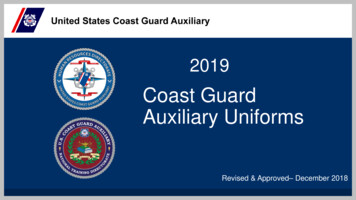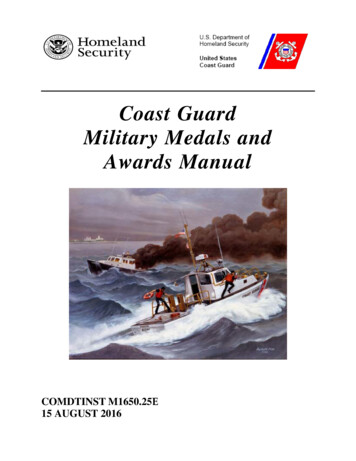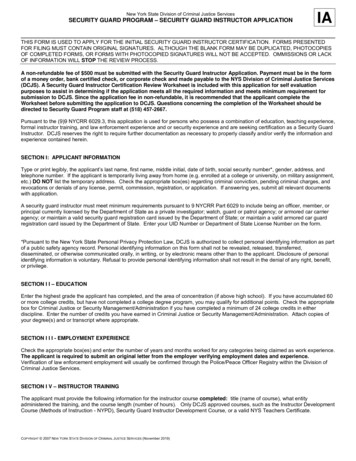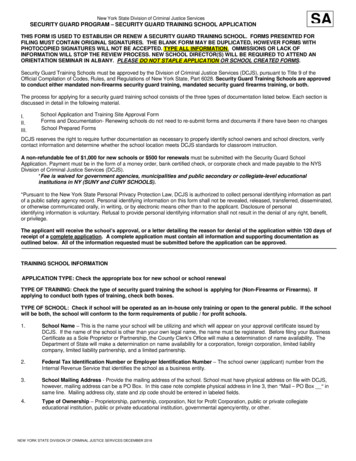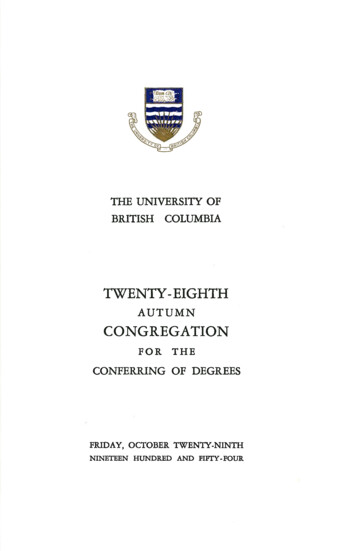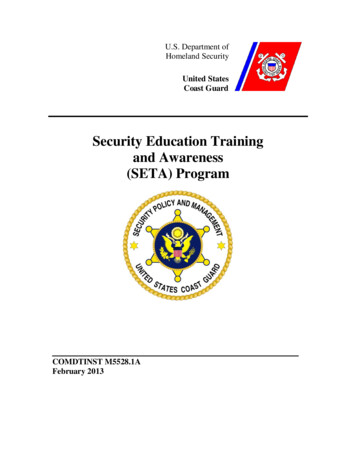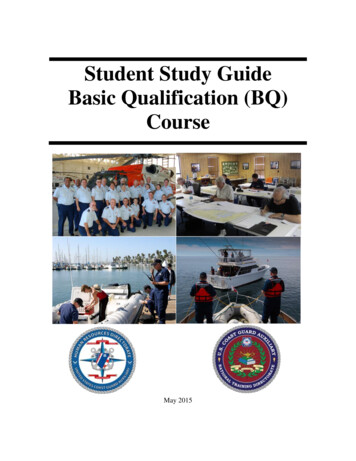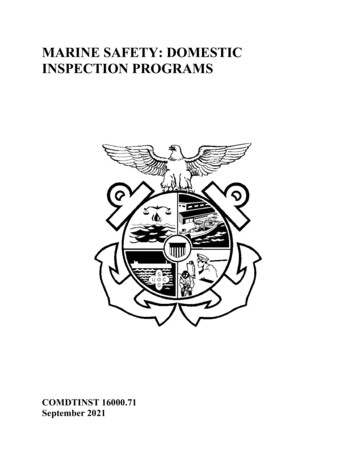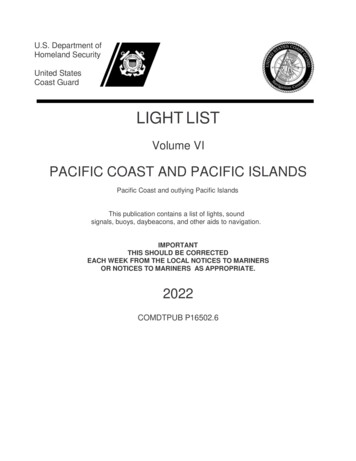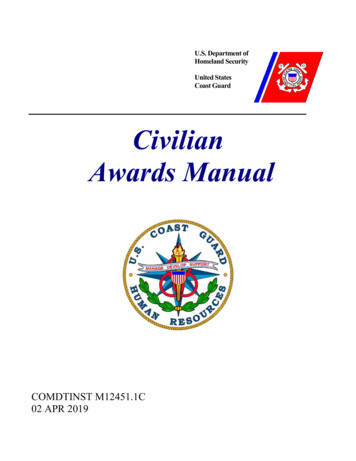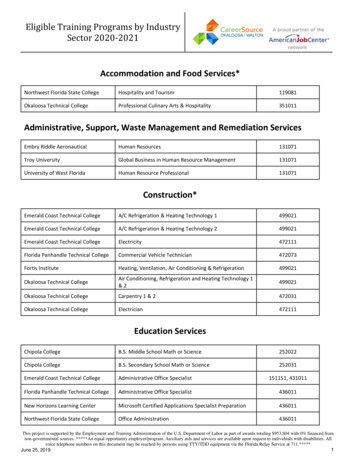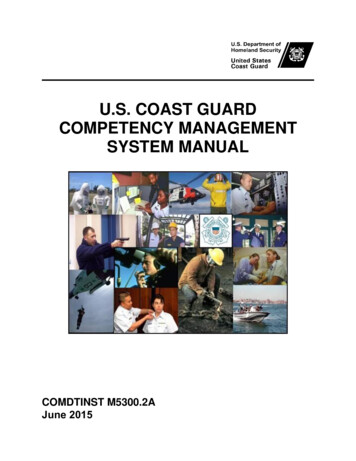
Transcription
U.S. COAST GUARDCOMPETENCY MANAGEMENTSYSTEM MANUALCOMDTINST M5300.2AJune 2015
CommandantUnited States Coast GuardUS Coast Guard Stop 79072703 Martin Luther King Ave, SEWashington, DC 20593-7907Staff Symbol: CG-1B1Phone: (202) 475-5025Email: lst-CG-1B1Competency@comdt.uscg.milCOMDTINST M5300.2A05 JUN 2015COMMANDANT INSTRUCTION M5300.2ASubj:U. S. COAST GUARD COMPETENCY MANAGEMENT SYSTEM MANUALRef:(a)(b)(c)(d)(e)(f)(g)(h)(i)Coast Guard Officer Specialty Management System Manual, COMDINST M5300.3 (series)Personnel and Pay Procedures Manual, PPCINST M1000.2 (series)Personnel Resources and Reprogramming Manual, COMDTINST M5312.13 (series)Military Assignments and Authorized Absences, COMDTINST M1000.8 (series)Enlisted Accessions, Evaluations, and Advancements, COMDTINST M1000.2 (series)Officer Accessions, Evaluations, and Promotions, COMDTINST M1000.3 (series)Mandatory Use of the Training Management Tool, COMDTINST 5270.2 (series)Reserve Policy Manual, COMDTINST M1001.28 (series)Military Separations, COMDTINST M1000.4 (series)1. PURPOSE. This Manual establishes policy and outlines specific practices and procedures for theemployment of the Coast Guard’s Competency Management System.2. ACTION. All Coast Guard unit commanders, commanding officers, officers-in-charge, deputy andassistant commandants, and chiefs of headquarters staff elements shall comply with the provisions ofthis Manual. Internet release is authorized.3. DIRECTIVES AFFECTED. U.S. Coast Guard Competency Management System Manual,COMDTINST M5300.2 is cancelled.4. DISCUSSION.a. The Competency Management System is a vital component of the Coast Guard’s ongoing effortto improve the capabilities of its Human Resource Management System. At the most basic level,the Competency Management System assists decision makers in better understanding theDISTRIBUTION – SDL No. XXXXXXXXXXXXXXXXXXXXXXXXXXNON-STANDARD XXXXXXXXXX
COMDTINST M5300.2Ademands of Service and job requirements, and the supply of people available to meet thosedemands. It provides a clear picture of the links that connect the highest-level organizational,strategic objectives to the work an individual member assigned to a specific unit performs.Through the accurate collection and management of competency data, the system improvesoperational performance while preserving the agility and flexibility for which the Service’spersonnel management system is known.b. It is our duty as leaders and good stewards of the Coast Guard’s resources to do everythingpossible to ensure our people understand the requirements of their specialty, subspecialty, ratingand job. Furthermore, it is our duty to ensure they are well-trained and prepared to meet thoserequirements. The Competency Management System provides an excellent method to track theknowledge, skills, abilities, education, and experience required for specific positions; it alsooffers a method of measuring our workforce’s ability to meet Service requirements. The endstate is an integrated human resource system that allows the Coast Guard to frame manpowerrequirements as well as recruit, train, distribute, and professionally mature our personnel basedon a common competency framework.c. The instrument that ensures the success of the Competency Management System is acomprehensive, flexible data management system. Direct Access (DA) is the primary system theCoast Guard uses to store and manage competency data. This Manual provides specific, detailedinformation regarding the use of DA to support Competency Management. The TrainingManagement Tool (TMT) http://aopsweb.osc.uscg.mil/aops.shtml, and the Aviation LogisticsManagement Information System (ALMIS) http://cgweb.almis.uscg.mil are also key elements ofthe system as they provide the direct means by which many users will capture certain types ofcompetency data for reporting into the system.d. There is a close relationship between the Competency Management System and the Coast GuardBusiness Intelligence (CGBI) System. CGBI is a system comprised of a data warehouse, andcontains processes and tools to extract data from the Coast Guard’s authoritative data sourcesand display that data in a manner relevant to the user.5. DISCLAIMER. This guidance is not a substitute for applicable legal requirements, nor is itself arule. It is intended to provide operational guidance for Coast Guard personnel and is not intended tonor does it impose legally-binding requirements on any party outside the Coast Guard.6. MAJOR CHANGES. While the intent and scope of this Manual remain the same, each chapter hasundergone the following significant changes:a. Memorandum: Updated all references and format.b. Chapter 1, 2, & 3: Reworked sentence structure throughout manual to eliminate passive voiceand wordy, confusing run-on sentences.c. Forms: Replaced actual forms in manual with hyperlinks to most-up-to-date forms. This willprevent the necessity to submit a manual change or update the manual each time a form isupdated.2
COMDTINST M5200.2Ad. Formatting: Removed chapter table of contents and updated page number format throughout.7. ENVIRONMENTAL ASPECT AND IMPACT CONSIDERATIONS.a. The development of this directive and the general policies contained within it have beenthoroughly reviewed by the originating office and are categorically excluded under currentUSCG categorical exclusion (CE) under USCG CE #33 from further environmental analysis, inaccordance with Section 2.B.2. and Figure 2-1 of the National Environmental Policy ActImplementing Procedures and Policy for Considering Environmental Impacts, COMDINSTM16475.1 (series).b. This directive will not have any of the following: significant cumulative impacts on the humanenvironment; substantial controversy or substantial change to existing environmental conditions;or inconsistencies with any Federal, State, or local laws or administrative determinations relatingto the environment. All future specific actions resulting from the general policies in this Manualmust be individually evaluated for compliance with the National Environmental Policy Act(NEPA), Council on Environmental Policy NEPA regulations at 40 CFR Parts 1500-1508, DHSand Coast Guard NEPA policy, and compliance with all other environmental mandates.8. DISTRIBUTION. No paper distribution will be made of this Manual. An electronic version will belocated on the following Commandant (CG-612) web sites. Internet: http://www.uscg.mil/directives/,and CGPortal: Pages/Home.aspx.9. PROCEDURE.a. The Competency Management System is designed to apply to both positions and personnel in allsegments of the workforce (Active Duty, Reserve, Civilian, and Auxiliary). Direct accesscontains “person profiles” for each individual member and “non-person profiles” for eachposition. Further, all positions will have a competency or an Officer Specialty Code assigned.All Officer positions will have at least one Officer Specialty Code assigned to that position.b. The Competency Management System is described in three parts. The first part is theCompetency Management System itself. The Second part is the Officer Specialty ManagementSystem. The third part is the Competency Dictionary, a dynamic online database that contains alist and description of every approved competency in the system.10. RECORDS MANAGEMENT CONSIDERATIONS. This manual has been evaluated for potentialrecords management impacts. The development of this manual has been thoroughly reviewed duringthe directives clearance process, and it has been determined there are no further records schedulingrequirements, in accordance with Federal Records Act, 44 U.S.C.3101 et seq., National Archives andRecords Administration (NARA) requirements, and the Information and Life Cycle ManagementManual, COMDTINST M5212.12 (series). This policy does not have any significant or substantialchange to existing records management requirements.11. FORMS/REPORTS. The forms referenced in this Manual are available in USCG Electronic Formson the Standard Workstation on the Internet: http://www.uscg.mil/forms/; CG Portal at3
COMDTINST itePages/Home.aspx; and Intranet athttp://cgweb.comdt.uscg.mil/CGForms.12. REQUEST FOR CHANGES. Requests for changes to this Manual can be sent directly to theCompetency Management System Administrator in Commandant (CG-1B1) via email:lst-CG-1B1-Competency@comdt.uscg.mil.C. B. ODOM, Acting/s/Assistant Commandant for Human Resources4
RECORD OF CHANGESCHANGENUMBERDATE OFCHANGEDATEENTEREDENTERED BY
COMDTINST M5300.2ATable of ContentsChapter 1.Competency Management System OverviewA.Purpose of the Competency Management SystemB.Competency Management System ArchitectureC.Organizational Structure: Roles, Responsibilities, and AuthoritiesD.Key Terms and DefinitionsE.Information Related to the Competency Management System1-11-11-31-41-51-6Chapter 2-112-13Chapter 3.IntroductionThe Competency SystemCompetency DictionaryEstablishing a CompetencyModifying a CompetencyAssigning Competencies to PositionsAssigning Competencies to MembersRemoving Competencies from MembersInactivating a CompetencyCompetency Management System ApplicationsA.IntroductionB.AccessionsC.Individual DevelopmentD.AssignmentsE.EvaluationsF.Promotions and AdvancementsG.SeparationsH.Tailored ReportsI.Unit Guide to Actions3-13-13-13-23-33-53-63-73-83-8List of Tables.Table 1-1.Table 1-2.Table 2-1.Table 2-2.Table 3-1.Roles, Responsibilities, and Authorities in the Competency Management SystemKey Competency Terms and DefinitionsCompetency ImportanceCompetency Verification TypesAccession Information Requirementsi1-41-62-72-113-2
COMDTINST M5300.2ATable 3-2. Individual Development Information Requirements3-3Table 3-3. Assignment Information Requirements3-5Table 3-4. Evaluation Information Requirements3-6Table 3-5. Promotions/Advancement Information Requirements3-7Table 3-6. Separations Information Requirements3-8List of Figures.Figure 1-1. Human Resource Management Linkage and AlignmentFigure 1-2. Integrated Competency Architecture for the Coast Guard1-21-3Appendices.A. Direct Access and the Competency Management SystemB. Analysis Process in the Competency Management SystemA-1B-1Enclosures.(1) Request to Assign Competencies, Education, or Officer Specialty to a Position, Form CG-5311(2) Request to Create, Change or Inactivate a Competency, Form CG-5311A(3) Pertinent Website Linksii
COMDTINST M5300.2AList of OXPODEFINITIONAdvanced Education ProgramAviation Logistics Management Information SystemAssignment OfficerArea of ResponsibilityArmed Services Vocational Aptitude BatteryCentral Assignment CoordinatorCoast Guard Business IntelligenceCoast Guard Recruiting CommandCompetency Management System AdministratorCommanding OfficerDirect AccessEnlisted Employee Review SystemEmployee Summary SheetOffice of Performance, Training & EducationHuman ResourcesIntegrated Accession PlanIndividual Development PlanOfficer Evaluation ReportOfficer Evaluation SystemOfficer In ChargeOfficer of the DeckOfficer Support FormOfficer Specialty ManagerPersonnel Allowance AmendmentPersonnel Allowance ListPersonnel Reporting Unit - see SPOProgram ManagerPlan of Action and MilestonesPoint of ContactPay and Personnel CenterPersonnel and Pay Procedures ManualPersonnel Qualification StandardCoast Guard Personnel Service CenterRequest for AnalysisRating Force Master ChiefSpecialty Force ManagerServicing Personnel Office (formerly PERSRU)Training Allowance BilletTraining Management ToolWatchstation Qualification StationExecutive OfficerExecutive Petty Officeriii
COMDTINST M5300.2AList of CMS Related OfficesCG OFFICESCG-1CG-1B1CG-631CG-751CG OFFICESAssistant Commandant for Human ResourcesFuture Force DivisionHR Systems Management DivisionOffice of Cutter Forcesiv
COMDTINST M5300.2ACHAPTER 1. COMPETENCY MANAGEMENT SYSTEM OVERVIEWA. Purpose of the Competency Management System.1.A competency is the job-related knowledge, skills, and abilities that a person exercises whileperforming the business of any given position.2.The definition of a competency is: “A collection of tasks with the associated skills,knowledge, abilities, and wherewithal (tools, methods, information, doctrine, procedures,materials, etc.) needed to perform the tasks to a predetermined, measurable, performancestandard. The tasks are usually related as parts of a larger process in support of orcontributing to the goals of the organization, unit, or work group.”3.The Competency Management System is an organized and structured group of relatedprocesses that includes:4.a.Establishing and modifying competencies,b.Assigning competencies to positions,c.Recording competencies earned by members,d.Collecting and organizing competency data and information, including its display, datacompilation, and use of the competency information in personnel management decisions.The Competency Management System serves a variety of purposes:a.The Competency Management System supports Coast Guard management activities thatrequire accurate information on position requirements and workforce capabilities.Human Resource (HR) Management activities exist to meet the needs of the Servicethrough its people, thereby increasing Service readiness and effectiveness.b.The Competency Management System links and aligns interdependent HR systemcomponents with the Coast Guard’s strategic direction and mission requirements. Figure1-1 illustrates:(1) In a vertical dimension, alignment must exist among the strategic goals and missionsof the organization, Coast Guard resources, support/operational activities thatsupport those goals, and the people that perform those activities.(2) In a horizontal dimension, alignment must exist between the processes that identifypersonnel requirements and the HR processes of accessions, individual development,assignments, evaluations, promotions, and separations. This horizontal linkage isdescribed in Chapter 3.1-1
COMDTINST M5300.2Ac.The Competency Management System improves the Service’s ability to supply the rightnumber of trained and qualified people to perform the Coast Guard’s varied missions, andallows them to assume greater responsibility and authority over time.d.The Competency Management System supports individual members by providingaccurate and real time information related to qualifications, career planning, trainingjustification, and promotion/advancement expectations.Figure 1-1. Human Resource Management Linkage and Alignmente.f.The Competency Management System promotes active comparison between thecompetencies required by positions (demand), as captured in DA non-person profiles andthe competencies held by members (supply), as captured in DA person profiles.Information from this comparison helps support personnel management decisions byreducing gaps between the requirements and the capabilities across the Service and overtime.The comparison between the competencies required by positions and the competenciesheld by members provides an indication of readiness. As such, the CompetencyManagement System is connected with the Personnel and Training dimensions of CGBI.1-2
COMDTINST M5300.2A5.The full benefit of the Competency Management System is realized when competencies areappropriately aligned with organizational requirements, captured for mission needs (demands),while members’ competencies are recorded and maintained. This is a primary and unifyingfocus of all HR Management activities. The Coast Guard can identify gaps and overlaps bytracking:a.The rate at which competencies are acquired through accessions, individualdevelopment, assignments, evaluations and promotions,b.The rate at which competencies are lost through attrition and separations,c.The creation of new requirements and associated costs caused by dynamically changingmissions as well as new missions.B. Competency Management System Architecture.1.Figure 1-2 displays the integrated competency architecture for the Coast Guard. Thearchitecture places the entire Competency Management System in the context of supply anddemand. It shows the linkage between the mission and strategic direction of the organization,the people, and the positions within the organization. The basic idea is that, like any otherorganization, demand for certain competencies in the Service is based on the nature of the workthe organization does. On the other side of the figure, members of the workforce supplycompetencies, and that supply can be adjusted over time using the HR processes of accessions,individual development, assignments, evaluations, promotions, and separations. Application ofinformation from the Competency Management System in these HR processes is fullydescribed in Chapter 3.Figure 1-2. Integrated Competency Architecture for the Coast Guard1-3
COMDTINST M5300.2A2.As shown in Figure 1-2, the demand for competencies is driven by mission requirements, andhelps generate organizational core competencies, unit competencies, and positioncompetencies. On the supply side, competencies reflect a member’s inventory of training,education, assignments, and other experiences. The collection of these competencies andaccomplishments make up a member’s competency portfolio, and also enables the Service tolabel the member with a particular specialty, subspecialty, or rating. The HR system thenmatches people to positions and may base those decisions, in part, on a member’scompetencies, choosing the member with the competencies that best support the needs of theService. A well-maintained competency management system supports all HR processesincluding accessions, individual development, assignments, evaluations, promotions andseparations, by tracking and matching competency demands to workforce capabilities.C. Organizational Structure: Roles, Responsibilities, and Authorities. The roles, responsibilities, andauthorities in the Competency Management System are shown in Table 1-1 below. These items arediscussed in more detail in the procedures listed in Chapters 2 and 3.Table 1-1. Roles, Responsibilities, and Authorities in the Competency Management ppendix ACG-8332-B-22-B-4ProgramManager (PMs)2-C-32-D-1Rating ForceMaster Chief(RFMCs)2-B-22-C-6RoleAct as the Competency Management System Administrator (CMSA).Coordinate the establishment, modification, inactivation, and definitionof competencies. This includes cross-programmatic coordination whencompetencies involve more than one Program Manager (PM).Establish procedures for data collection, data integrity, and datacurrency.Maintain Competency Dictionary.Perform technical and administrative review of Competency ChangeForms submitted by PMs.Return proposed changes that are not in compliance with establishedprocedures to PMs.Process requests for inactivation of competencies.Provide Commandant (CG-1) with the guide of what each pageaccomplishes in Direct Access.Approve Personnel Allowance List (PAL) changes driven by updated ornew competencies that require a rank, grade, specialty, subspecialty, orrating change in a given position, or creation of a new position.Establish and define competencies for positions that fall within theirProgram.Review and update competency definitions regularly.1-4
COMDTINST M5300.2AResponsibilitySpecialty st cl (1)Encl (2)2-F-32-F-42-D-22-C-62-I-21-B-2Appendix BAppendix BServicingPersonnelOffices (SPO)2-B-2CommandingOfficers (CO)2-C-72-D-2Encl (1)2-B-23-I-12-G-12-G-32-H-12-H-4RolePropose changes to competencies by submitting a Request to AssignCompetencies, Education, or Officer Specialty to a Position, FormCG-5311 to Commandant (CG-1B1).Designate and review requests to designate competencies for positionswithin their Program.Establish and maintain requirements for earning a competency.Assist PMs in the biannual review of competencies in their AOR.Request to inactivate a competency.Use the Competency Management System as a tool to manageassignments, advancements, promotions, separations, and evaluationsEstablish procedures for conducting competency/performanceintervention analysis of items identified by PMs in their reviews.Assist PMs in conducting further analysis.Enter individual member competency information into DA whenprovided with proper documentation and per existing procedures andstandards.Propose the establishment of new competencies or changes to existingcompetencies to PMs via chain of command.Review and recommend competency requirements for positions withintheir unit.Award competencies earned by members; submit appropriate data entryforms.Make decisions concerning removal of previously earned competencies.D. Key Terms and Definitions. This Manual uses many terms and definitions the reader mustunderstand to gain a full understanding of the Competency Management System. Table 1-2contains the most important terms used here. A comprehensive list of HR terms and definitions canbe found on the CG Portal. See Enclosure (3).E. Information Related to the Competency Management System. Beyond recording competencies, theCoast Guard uses DA to record the information used to establish personnel capabilities. Examplesmay include, but are not limited to the following:1.2.3.4.5.6.Education and Degree informationLicenses and CertificationsHonors and AwardsCoast Guard Non-Resident course completion testsCoast Guard Class “A”, “C”, Non-resident courses, and PQSAssignment History1-5
COMDTINST M5300.2ATable 1-2. Key Competency Terms and DefinitionsTermAccomplishmentDefinitionA tangible achievement. An accomplishment may be an individual’s degree,license, certification, language proficiency, test score, honor, award, orprofessional membership. Accomplishments have specified achievement datesand may have defined durations or expiration dates.BroadenedSpecialistAn officer who possesses in-depth knowledge and skills in two or more officerspecialties or subspecialties through education, training, and/or Serviceexperience.CertificationAn endorsement in written form by a recognized government authority (i.e. CO orOIC) or delegated representative that specifies standards of knowledge orperformance have been met in a particular subject area, e.g. a certified publicaccountant.CompetencyA collection of tasks with the associated knowledge, skills, abilities, andwherewithal (tools, methods, information, doctrine, procedures, materials, etc.)needed to perform the tasks to a predetermined, measurable, performancestandard. The tasks are usually related as parts of a larger process in support of orcontributing to the goals of the organization, unit, or work group.Competency CodeA unique code that identifies a Competency in DA. This code is limited to 8characters.Direct Access(People Soft)DepartmentThe Coast Guard’s central military pay and personnel data management system.Department IDA unique 6-digit number used in DA to identify all units and subunits in the CoastGuard.EmployeeA DA term used to describe all Coast Guard personnel; military and civilian.EmployeeCompetenciesTerm used in DA to describe the competencies possessed by an individual whohas met the required standards for assignment.A DA term used to describe a Coast Guard unit or subordinate element of a unit.Used in place of the terms “Unit” or “subunit.”Employee IDA unique 7-digit number used in DA to identify all members in the Coast Guard.Number (EMPLID) (Active Duty, Reserve, Civilian, and Auxiliary)ImportanceA DA term of measurement used to establish the desired/required need for thecompetency for an assigned position. This characteristic is assigned to acompetency when it is attached to a position.LicenseA legal document issued by a government entity giving officialauthority/permission to perform certain acts or to carry on a certain business, i.e. adriver’s license.1-6
COMDTINST M5300.2ATable 1-2 (cont). Key Competency Terms and DefinitionsTermOrganizational CoreCompetenciesDefinitionCoast Guard-wide competencies that potentially apply to everyProgram in the Coast Guard. These are “enduring attributes thatenable successful mission performance of the organization.” TheCoast Guard’s core competencies emerge from decades of experiencein pursuing missions. They are the accumulation of lessons learnedfrom repeated action, observation, and experimentation. Many ofthese lessons are now so ingrained as to be implicit and an integralpart of the Coast Guard’s culture.Officer SpecialtyAs defined in Reference (a), an area of expertise defined by a set ofcompetencies and possessing an authorized billet structure capable ofsustaining a viable population of career specialists who have requisitework experience, education, training, certification, or license.Officer SpecialtyCodeAs defined in Reference (a), a unique 8-character (seven digit) codeused in DA to identify all Officer Specialties and Subspecialties in theCoast Guard.Officer SpecialtyManagerAs defined in Reference (a), a person who performs a function similarto the RFMC. OSMs are primarily assigned to perform this functionas a collateral duty on the staff of a given Headquarters PM.Officer SubspecialtyAs defined in Reference (a), a focused area of expertise within aspecialty defined by competencies acquired through work experience,education, training, certification, or license. Officers may acquiremultiple subspecialties during the course of their careers.Personnel AllowanceList (PAL)The position allocation of a unit as defined by the unit OFCO and anysubsequent approved changes.PortfolioA list of a member’s competencies and other accomplishmentsincluding: knowledge, skills, abilities, degrees, education, training,certifications, and licenses. The term “portfolio” might also bereferred to as a Personal Portfolio and/or Competency Portfolio.PositionTerm used to describe all authorized military and civilian positions inthe Coast Guard. It includes the following information as appropriate:pay grade, specialty information (civilian series, warrant specialty,enlisted rate, or Officer Specialty Code), location (Unit/Dept),title/description, funding source, sponsoring program, requiredqualifications or training, billet/position expiration dates, AC&Iproject affiliations, and other administrative fields.1-7
COMDTINST M5300.2ATermPositionCompetenciesDefinitionTerm used in DA to describe the competencies assigned to Positionsvia the Position Number. Position Competencies are assigned by a CGProgram to ensure job quality match.Position NumberA unique 8-digit number used in DA to identify all positions in theCoast Guard.ProficiencyA measurable, established level of skill or ability required for thecompetency attached to a specific position. This characteristic isassigned to a competency when it is attached to a position.Program CoreCompetenciesProgram-wide competencies that potentially apply to an entireprogram specialty and its subspecialties in support of Coast GuardMissions.Program ManagerThe staff officer at Headquarters designated by, and accountable to,the Program Director for the detailed management of a Coast GuardProgram.Rating Force MasterChief (RFMC)RFMCs are the principal advocate for their rating and are responsiblefor the overall health of the rating. RFMCs manage the structure ofand develop requirements for their workforce to ensure personnel areprepared to meet current and future missions. RFMCs develop andmanage competencies uniquely related to their rating for thesponsoring Program.Specialty ForceManager (SFM)A person who performs a function similar to the RFMC. TheSpecialty Force Managers serves as the advocate and technicalauthority for the Warrant Officer Specialties they represent for thedesignated Headquarters Program Manager.Training AllowanceBillet (TAB)That portion of the General Detail used to support military personnelin fully-funded training and AEPs.1-8
COMDTINST M5300.2ACHAPTER 2. POLICYA. Introduction. This chapter addresses two primary topics associated with the CompetencyManagement System.1.Section B focuses on policy as it relates to the information system used to store and managecompetency-related information.2.Section C describes the policy framework for establishing, changing, and managingcompetencies.B. The Competency System.1.Direct Access. A critical piece to any competency management system is a current, accuratedatabase to capture, store, and maintain competency information, both by position and onindividual members. DA is the system of record for HR data. DA contains a robustcompetency management section that serves as the foundation for the CompetencyManagement System.2.Responsibilities.a.Commandant (CG-631) is the IT Portfolio manager and acts as the intermediary,providing direction to the Direct Access System Development Activity/System SupportActivity (SDA/SSA). CG-631 directs the SDA/SSA’s actions for configuration,development, upgrades, operation, and maintenance as requested by the CG-1 PMO.b.Commandant (CG-1B1) is responsible for developing and establishing procedures forcollecting and managing data for the competency management system. Throughout theapproval processes described in sections 2.D. through 2.I., the Competency ManagementSystem Administrator (CMSA) shall initiate the exchange of information and approvalactivities of the parties involved. Deadlines shall be set to submit input either in favor ofor against the action being requested, either in whole or in part. If there is disagr
Mar 16, 2017 · Figure 1-1. Human Resource Management Linkage and Alignment 1-2 Figure 1-2. Integrated Competency Architecture for the Coast Guard 1-3 Appendices. A. Direct Access and the Competency Management System A-1 B. Analysis Pr
